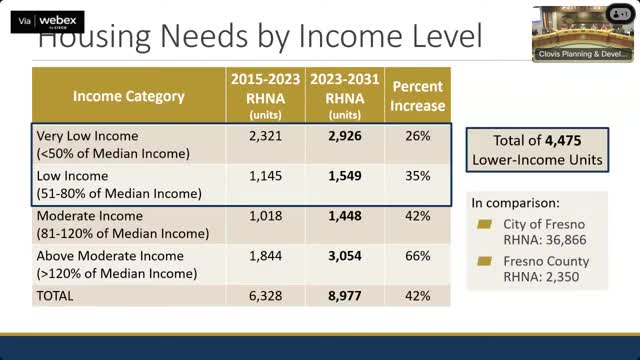Cities face housing crisis as RHNA targets soar
October 04, 2024 | Clovis, Fresno County, California
This article was created by AI summarizing key points discussed. AI makes mistakes, so for full details and context, please refer to the video of the full meeting. Please report any errors so we can fix them. Report an error »

In a recent government meeting, officials discussed the Regional Housing Needs Assessment (RHNA) for the 2023 to 2031 cycle, highlighting significant increases in housing targets across California. The city of Clovis faces a RHNA of 8,910 units, while Fresno's target is nearly 37,000 units, and the county's is set at 23,100 units. A key focus of the discussion was the challenge of accommodating lower-income housing, with Clovis needing to provide 4,475 units in this category, which is often the most difficult for cities to achieve.
The meeting provided context on income limits for various household sizes, noting that a low-income household of three should earn around $56,000 annually, with an affordable monthly rent of approximately $1,400. To meet these housing targets, city officials are tasked with preparing a detailed inventory of available land for development, including both vacant and potentially redevelopable sites.
The officials presented a mapping of these sites, categorized by income levels: lower income sites are designated for areas allowing at least 30 units per acre, while moderate income sites accommodate slightly lower densities. Above moderate income housing is primarily found in single-family residential zones. The mapping indicates that housing for various income levels is distributed throughout the city, particularly in areas with the highest growth potential.
In conclusion, the city has demonstrated adequate capacity to meet its RHNA across all income levels, indicating a surplus capacity that could facilitate the development of necessary housing units. This proactive approach aims to address the pressing housing needs within the community while adhering to state mandates.
The meeting provided context on income limits for various household sizes, noting that a low-income household of three should earn around $56,000 annually, with an affordable monthly rent of approximately $1,400. To meet these housing targets, city officials are tasked with preparing a detailed inventory of available land for development, including both vacant and potentially redevelopable sites.
The officials presented a mapping of these sites, categorized by income levels: lower income sites are designated for areas allowing at least 30 units per acre, while moderate income sites accommodate slightly lower densities. Above moderate income housing is primarily found in single-family residential zones. The mapping indicates that housing for various income levels is distributed throughout the city, particularly in areas with the highest growth potential.
In conclusion, the city has demonstrated adequate capacity to meet its RHNA across all income levels, indicating a surplus capacity that could facilitate the development of necessary housing units. This proactive approach aims to address the pressing housing needs within the community while adhering to state mandates.
View full meeting
This article is based on a recent meeting—watch the full video and explore the complete transcript for deeper insights into the discussion.
View full meeting
